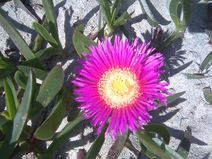Carpobrotus aequilaterus
| Carpobrotus aequilaterus | |
 | |
| Light: | |
| Moisture: | |
| Hardiness: | 8 |
| Soil pH: | 5.6-8.4 |
| Evergreen | |
| Height: | 1' |
| Width: | 7' |
| Native to: | |
| Edible Rating: | |
| Tea: | Yes |
Carpobrotus aequilaterus (common name: sea fig) is a perennial evergreen member of the Carpobrotus genus.
Propagation: Seed - surface sow March to June in a greenhouse. Lower night-time temperatures are beneficial. The seed usually germinates in 7 - 10 days at 23°c[1]. When they are large enough to handle, prick the seedlings out into individual pots and grow them on in a greenhouse for at least their first winter. Plant them out into their permanent positions in late spring or early summer, after the last expected frosts.
Cuttings at any time during the growing season. Allow the cutting to dry in the sun for a day or two then pot up in a very sandy mix. Very easy[K].
Cultivation: Requires a well-drained sandy soil in a sunny position[2][3]. Plants can be grown on dry walls or in the flower border[4]. Established plants are very drought resistant[3]. Very resistant to wind and salt spray[4]. Moderately fire-retardant[3].
Plants are not very frost resistant, tolerating temperatures down to between -5 and -10°c, and only succeeding outdoors in the milder areas of the country[3].
A vigorous prostrate plant, rooting as it spreads. The flowers only open in the afternoon[3].
Range: Southern N. America - California, Mexico. Australia - New South Wales, Tasmania, Victoria.
Habitat: Naturalised in California where it grows along the coastal strand and in coastal sage scrub at elevations up to 100 metres[5].
Edibility: Fruit - raw[6]. They are said to remotely suggest the flavour of strawberry[7].
Leaves - baked[7]. We find them too mucilaginous to be enjoyable[K].
Usage: Planted in maritime areas to prevent soil erosion in sandy soils and on steep banks[3][8].
The plant is moderately fire-resistant and can be used in barrier plantings to prevent the spread of forest fires[3].
Pollinators: Bees
Soil: Can grow in light and medium soils.
Drainage: Prefers well drained soil.
Wind: Tolerates maritime wind exposure
In Leaf: Evergreen
Flower Type: Hermaphrodite
Links
References
- ↑ Bird, R. Growing from Seed Volume 3. Thompson and Morgan, 1989.
- ↑ Chittendon, Fred. RHS Dictionary of Plants. Oxford University Press, 1951.
- ↑ 3.0 3.1 3.2 3.3 3.4 3.5 3.6 Huxley, Anthony. The New Royal Horticultural Society Dictionary of Gardening. MacMillan Press, 1992.
- ↑ 4.0 4.1 Taylor, Jane. The Milder Garden. Dent, 1990.
- ↑ Flora of California.
- ↑ Moerman, Daniel. Native American Ethnobotany. Timber Press, 1998.
- ↑ 7.0 7.1 Facciola, Stephen. Cornucopia - A Source Book of Edible Plants. Kampong Publications, 1990.
- ↑ Carolin, R. Flora of the Sydney Region. Reed, 1993.